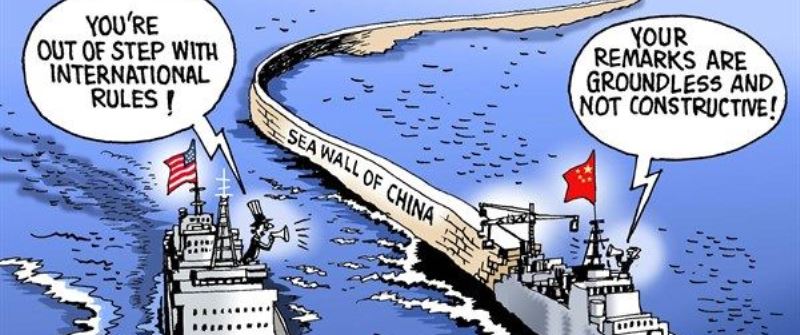
13 Apr Blog: The South China Sea dispute and international law: time to put reality back on the table
By Fenna Egberink
The South China Sea dispute is often portrayed as an archetypal case of an overbearing great power bullying its weaker neighbours. A common kneejerk reaction to this seemingly unsolvable dispute has been to look for ways in which the regional troublemaker, China, can be disciplined. Fenna Egberink argues that international law has proven to be an appealing but eventually unrealistic option.
On 12 July 2016, an arbitral tribunal published its decision on a case submitted by the Philippines to the Permanent Court of Arbitration (PCA) in 2013. The Philippines had asked for a ruling on (a.o.) whether China’s claim to the South China Sea (SCS) and its encroachments in that area were in accordance with international law. The tribunal ruled overwhelming in favour of the Philippines, decreeing that the basis of the Chinese claim (‘historical rights’) was forfeited when China became a signatory to the United Nations Convention on the Law of the Sea (UNCLOS). It also ruled that a portion of the area claimed by China lies within the Philippine Exclusive Economic Zone, making Chinese actions in these areas unlawful.
The ruling provoked an array of responses from Western commentators and governments, mostly urging China to respect and implement the ruling (as opposed to completely rejecting the decision, as it immediately did). These responses from Western commentators and governments are in line with a structural tendency to respond to the inadequacy of existing agreements and frameworks by calling for better, binding, and preferably enforceable mechanisms. For those outside the immediate region, the seemingly unsolvable conflict and, especially, the fact that no outside entity or individual seems to be able to influence it, is very frustrating. All international rules, frameworks, and diplomatic codes of conduct notwithstanding, China’s SCS policy remains unaffected to this day.
The PCA case was not the first legal instrument brought to the SCS. The UNCLOS intended to ‘bring a stable order to mankind’s very source of life’. For the SCS however, UNCLOS hasn’t had the intended effect. The May 2009 deadline for Submissions on the Limits of the Continental Shelf was the catalyst for the Chinese Note Verbale, in which it asserted ‘indisputable sovereignty’ over a mapped area appearing to include the entire SCS. This submission alarmed states both within and outside the region, and is often seen as one of the reasons for the rise in clashes since 2009, including conflicts involving Chinese military activities close to Southeast Asian coast lines, maritime encounters (both naval and commercial), and continuing Chinese land reclamation, with China’s takeover of the Scarborough Shoal eventually triggering the PCA case.
The affected Southeast Asian countries, in contrast to Western governments, show a lack of structural outrage about China’s incursions in their ‘backyard’. The many open diplomatic rows in the past few years call into question a perception of an altogether uncritical position towards China, but their primary response to the arbitral ruling was limited to urging both parties to show restraint and engage in dialogue. Their seemingly lacklustre response to the far-reaching decision is in contrast to their active diplomacy in the lead up to the ruling, and the general prominence of international law in their discourse about the SCS. The countries (including China) consistently call on each other to respect the 2002 Declaration of Conduct (DoC) (in which they agreed to refrain from any actions potentially exacerbating the dispute), engage in endless discussions about the interpretation of UNCLOS provisions, and, with the exception of China, repeatedly stress the need for a binding legal framework.
The SCS case thus puts into question the oft-professed value of international law in international relations, and the value of ‘binding’ agreements more broadly. In my view, the distinction between international law as something that ‘is’ and international politics as something one ‘does’ is inadequate, as it renders international law as an institution distinct from the world of high politics, from the boots on the ground (or ships in the sea…), and from diplomatic efforts to regional cooperation. There is a stark paradox in this reasoning, as shown by the loose ends in UNCLOS that have triggered so much debate the past years, and which reflect the limits of political consensus-making during the drafting process. In artificially separating law from politics, we overlook the fact that international politics was the very facilitator of international law.
In the case of the SCS, the conundrum is simple: although one could indeed argue that China should heed the ruling of the tribunal, and should have cooperated with the tribunal to begin with, the reality is that it hasn’t. It is a moot point to insist on the implementation of a ruling China has rejected from the onset. The response from the other littoral states, then, appears to be an acknowledgement that the ruling has no merit on its own, but rather reflects the political reality of the region; of the dispute, of the political state of East Asia, and of intra-Southeast Asian relations. And in this domain of political reality, Southeast Asia places its bets.
The problem with focusing on law or other enforceable mechanisms to manage or resolve the SCS dispute is that it takes reality off the table. Political reality dictates that legal frameworks only work when they are supported. Until that time, the Southeast Asian countries are indeed better off not wasting their diplomatic leverage on an ideological deadlock.
(Fenna Egberink’s research interest lies firmly with Southeast Asia, most notably intra-Southeast Asian relations, Sino-Southeast Asian relations, Asian security issues and Asian regional cooperation such as through ASEAN. Fenna has a particular interest in the South China Sea dispute, which embodies the intricacy of regional and extra-regional relations, security interests and the region’s specific historical backdrop and geographical makeup).




No Comments